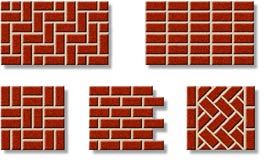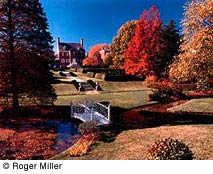The textures in the exteriors and interiors of homes in colonial America in the 18th century were often rough. |
Intro 1 / Period Style 2 / Georgian History 3 / Shape 4 / Materials 5 / Structure 6 / Color 7 / Texture 8 / Size |
Bricks
had to be made by hand and were not always perfectly formed and
colored. Wood came from numerous kinds of trees and showed diffe rent grains and hues. Plaster was not always
applied by a skilled craftsman and was rarely smooth and even
on the walls. Moldings that were decorated with ornaments were
usually unbalanced and seldom uniform. Furniture was not always
varnished and properly finished with matching hardware. Glass
was rarely completely clear and without the residue of sand and
ripples. Fabrics were nubby and uneven in weights and coloring.
rent grains and hues. Plaster was not always
applied by a skilled craftsman and was rarely smooth and even
on the walls. Moldings that were decorated with ornaments were
usually unbalanced and seldom uniform. Furniture was not always
varnished and properly finished with matching hardware. Glass
was rarely completely clear and without the residue of sand and
ripples. Fabrics were nubby and uneven in weights and coloring.
Paint had a chalky, milky look. Silver usually had slight imperfections
from scratches and tool markings. Rugs, if they existed, were
coarse, with a hard nap.
However, all of these materials were essential to comfortable living and this was the best available to the colonists unless imported from England. Of course, things changed when more artisans arrived from Europe and weaving technology improved with better looms for fabrics and carpets. But textures for the Georgian Colonial style do include a sort of coarseness that had a less polished look.
Fabrics made with needlepoint were used for dining and important smaller chairs. Jacquards and Damasks became increasingly popular and are often best seen in silk or linens.
 Chintz was a big material for this era. Their
big patterns gave a sense of texture to plain whitewashed walls
with painted molding.
Chintz was a big material for this era. Their
big patterns gave a sense of texture to plain whitewashed walls
with painted molding.
Floors were typically made of wood boards and were left with an unvarnished kind of look. Sisal and rag rugs were suitable for more casual rooms. In general, the more refined the room the smoother the textures. Smooth, slick, very even textures are hallmark of more refined Georgian interiors.
Carved
wood banisters, moldings, pilasters and columns add real authentic
detail to the Georgian look. The variations of v's and circles
in trim (egg and dart) and  fluting
in the pilasters increase textural interest and are architectural
elements important to the classical style. And no Georgian home
is complete without circular ceiling mounts in plaster, near
the hanging chandelier.
fluting
in the pilasters increase textural interest and are architectural
elements important to the classical style. And no Georgian home
is complete without circular ceiling mounts in plaster, near
the hanging chandelier.
Variations of stones, marbles and woods complete the important focal point of that ubiquitous fireplace. Delft tiles were popular decorative surrounds too.
The use of orders and ornaments around and on the mantels are important. This was and should be treated as the focal point of the interior.
 Exterior textures include rustication
and surrounds near the center doors and windows. This decorative
stonework or brickwork accentuated the classical design style
and drew attention to the symmetry of the design. Brick patterns
and bonding create different looks and textures, and at one time
were a tell tale of a person's wealth. Brick is the iconic building
material for the Georgian Style.
Exterior textures include rustication
and surrounds near the center doors and windows. This decorative
stonework or brickwork accentuated the classical design style
and drew attention to the symmetry of the design. Brick patterns
and bonding create different looks and textures, and at one time
were a tell tale of a person's wealth. Brick is the iconic building
material for the Georgian Style.
It is important to mention that gardens, views and vistas were very significant characteristics of Georgian Design. The homes and gardens were considered connected. The colors and textures of the landscapes accentuated the colors and textures of the interiors. Garden furniture and statuary were features of the more grand homes and were constructed for visual enjoyment. Coarse stone benches, marble bird baths, the smoothness of a reflecting pool, a wide variety of plant and tree material - all these things create a blend of landscapes and buildings in unity. This is one of the most divine textural and colorful features of this Period style look!
The Paca House shown below is a prime example.

Previous / Intro /
1 / 2 / 3 /
4 / 5 / 6 / 7 /
8 / Next
Subscribe to our free and extremely informational newsletter. We would love to have your comments at: mail@designintuit.com
Welcome / What We're About / Focus on Annapolis / Marco Polo's Quest / Michelangelo's Den / Great Sites & Sources / Reading / Tiles & Textures / Tools & Terms / Contact Us
This site design and text © DesignIntuit, 2001